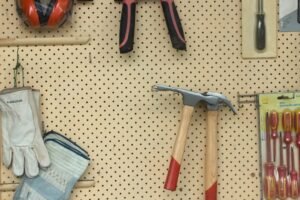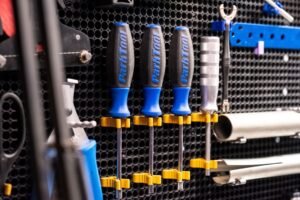Workspace organization is crucial for enhancing productivity and efficiency. A disorganized, cluttered workspace can result in time wastage and frustration when searching for necessary tools and materials. Conversely, a well-organized workspace facilitates efficient work, improved focus, and faster task completion.
It also creates a more pleasant environment, potentially boosting mood and overall well-being. An organized workspace also contributes to improved safety. Scattered tools and materials increase the risk of accidents and injuries.
By maintaining an organized, clutter-free workspace, a safer environment is created for all occupants. Additionally, proper organization can lead to cost savings by preventing loss or damage to tools and materials. When items have designated places, they are less likely to be misplaced, lost, or damaged.
The benefits of workspace organization are significant and far-reaching. It enhances productivity, efficiency, and safety while potentially reducing costs. Investing time in organizing a workspace can create a more functional and pleasant environment, yielding numerous advantages.
Key Takeaways
- A well-organized workspace can improve productivity and efficiency
- Choose the right tools holder that suits your specific needs and space constraints
- Maximize space in your workspace by utilizing vertical storage and decluttering regularly
- Arrange and categorize your tools based on frequency of use and type
- Regular maintenance and cleaning of your workspace is essential for a tidy and safe environment
- Get creative with DIY tools holder ideas to personalize your workspace
- A well-organized workspace can lead to reduced stress, improved focus, and a more enjoyable work environment
Choosing the Right Tools Holder for Your Needs
Considering Your Workspace
For example, if you have a small workspace with limited floor space, a wall-mounted rack or pegboard may be the best option as it allows you to keep your tools organized and easily accessible without taking up valuable floor space. On the other hand, if you have a larger workspace with ample floor space, a toolbox or drawer organizer may be more suitable as it provides ample storage for a wide variety of tools and materials.
Tool Frequency and Accessibility
It’s also important to consider the type of tools you have and how often you use them when choosing a tools holder. For frequently used tools, a wall-mounted rack or pegboard near your work area may be the best option for easy access. For less frequently used tools, a toolbox or drawer organizer may be more suitable for keeping them organized and out of the way until needed.
Creating an Organized Workspace
In conclusion, choosing the right tools holder for your needs is essential for creating an organized and functional workspace. Consider the layout of your workspace, the type of tools you have, and how often you use them when selecting a tools holder that will help you keep your workspace tidy and efficient.
Tips for Maximizing Space in Your Workspace

Maximizing space in your workspace is essential for creating an organized and functional environment. There are several tips and tricks you can use to make the most of the space you have available. One tip is to utilize vertical space by installing shelves or wall-mounted racks to store tools and materials.
This can help free up valuable floor space and keep your workspace tidy and organized. Another tip is to invest in multi-functional furniture or storage solutions that can serve multiple purposes, such as a workbench with built-in storage or a rolling cart with drawers. Additionally, it’s important to regularly declutter and purge items that you no longer need or use.
This can help free up space and prevent your workspace from becoming overcrowded and disorganized. Consider implementing a “one in, one out” rule where you only bring in new items if you are willing to part with something else. Furthermore, consider using transparent storage containers or labels to easily identify and locate tools and materials.
This can help save time and prevent frustration as you search for specific items in your workspace. In conclusion, maximizing space in your workspace is essential for creating an organized and efficient environment. By utilizing vertical space, investing in multi-functional storage solutions, decluttering regularly, and using transparent storage containers or labels, you can make the most of the space you have available and create a more functional workspace.
How to Arrange and Categorize Your Tools
| Category | Tools | Benefits |
|---|---|---|
| Hand Tools | Screwdriver, Hammer, Pliers | Easy to access and use for small tasks |
| Power Tools | Drill, Saw, Sander | Efficient for heavy-duty tasks |
| Measuring Tools | Tape Measure, Level, Square | Ensure accuracy in projects |
| Storage Solutions | Toolbox, Pegboard, Tool chest | Keep tools organized and easily accessible |
Arranging and categorizing your tools is essential for creating an organized and efficient workspace. There are several methods you can use to arrange and categorize your tools to make them easier to find and use. One method is to group similar tools together.
For example, you can create separate areas for hand tools, power tools, measuring tools, and fasteners. This can help you quickly locate the specific type of tool you need without wasting time searching through a jumble of mixed items. Another method is to arrange your tools based on frequency of use.
Keep frequently used tools within easy reach of your work area for quick access, while less frequently used tools can be stored in a separate area or higher up on shelves or racks. It’s also important to consider the layout of your workspace when arranging and categorizing your tools. Keep frequently used tools within arm’s reach of your work area to minimize time spent searching for them.
Additionally, consider creating designated storage areas for each category of tools to keep them organized and easily accessible. In conclusion, arranging and categorizing your tools is essential for creating an organized and efficient workspace. By grouping similar tools together, arranging them based on frequency of use, and considering the layout of your workspace, you can make it easier to find and use the tools you need for any task.
Maintaining a Clean and Tidy Workspace
Maintaining a clean and tidy workspace is essential for productivity, efficiency, and safety. There are several tips you can use to keep your workspace organized and clutter-free. One tip is to clean up as you go.
After completing a task, take a few minutes to put away tools and materials, wipe down surfaces, and sweep or vacuum the floor. This can help prevent clutter from building up and make it easier to start fresh on your next project. Another tip is to establish a regular cleaning schedule.
Set aside time each week or month to thoroughly clean and organize your workspace. This can help prevent clutter from accumulating and ensure that your workspace remains tidy and functional. Additionally, consider implementing a “clean desk” policy where you clear off your work surface at the end of each day.
This can help create a fresh start for the next day’s work and prevent clutter from accumulating on your work surface. In conclusion, maintaining a clean and tidy workspace is essential for productivity, efficiency, and safety. By cleaning up as you go, establishing a regular cleaning schedule, and implementing a “clean desk” policy, you can create a more pleasant and functional environment that will benefit you in numerous ways.
Creative DIY Tools Holder Ideas

Repurposing Old Items
One idea is to repurpose old items such as pallets, crates, or even old kitchen utensil organizers into unique tools holders. This not only helps reduce waste but also adds a touch of creativity to your workspace.
Custom Tool Holders
Another idea is to create custom tool holders using PVC pipes or wooden dowels. These can be mounted on walls or placed on workbenches to keep tools organized and easily accessible. You can customize the size and layout of these holders to fit your specific needs.
Magnetic Tool Holders
Additionally, consider using magnetic strips or boards to hold metal tools such as wrenches, screwdrivers, or pliers. This not only keeps them organized but also makes them easily visible and accessible.
In conclusion, there are plenty of creative DIY tools holder ideas that can help you organize your workspace in a unique and personalized way. Whether it’s repurposing old items, creating custom tool holders, or using magnetic strips or boards, there are endless possibilities for organizing your tools in a creative and functional manner.
The Benefits of a Well-Organized Workspace
A well-organized workspace offers numerous benefits that can improve productivity, efficiency, safety, and overall well-being. One benefit is improved productivity. When everything has its place and is easily accessible, it reduces time spent searching for tools or materials, allowing you to focus on the task at hand.
Another benefit is improved efficiency. An organized workspace allows you to work more efficiently by minimizing distractions and preventing clutter from getting in the way of your work. This can help you complete tasks more quickly and with greater accuracy.
Furthermore, a well-organized workspace can improve safety by reducing the risk of accidents or injuries caused by cluttered or disorganized work areas. When tools and materials are stored properly and out of the way when not in use, it creates a safer environment for everyone. In addition to these practical benefits, a well-organized workspace can also have a positive impact on your mood and overall well-being.
A tidy and organized environment can reduce stress and create a more pleasant atmosphere in which to work. In conclusion, the benefits of a well-organized workspace are numerous and far-reaching. From improved productivity and efficiency to enhanced safety and well-being, taking the time to organize your workspace can have a positive impact on every aspect of your work life.
Check out this fascinating article about Vermont filmmaker’s journey culminating in an Oscar-nominated film “Past Lives” here. It’s a great example of how dedication and hard work can lead to incredible success in the film industry. And just like a filmmaker needs the right tools to bring their vision to life, having the right tools holder can make all the difference in completing a project efficiently and effectively.
FAQs
What is a tools holder?
A tools holder is a device used to organize and store various tools in a convenient and accessible manner. It is designed to keep tools secure and prevent them from getting lost or damaged.
What are the different types of tools holders?
There are various types of tools holders available, including tool belts, tool bags, tool boxes, tool cabinets, and tool racks. Each type is designed to accommodate different types of tools and serve different purposes.
What are the benefits of using a tools holder?
Using a tools holder helps to keep tools organized, easily accessible, and in good condition. It also helps to improve efficiency and productivity by reducing the time spent searching for tools.
How to choose the right tools holder?
When choosing a tools holder, consider the types and sizes of tools you need to store, the available storage space, and the portability requirements. It’s important to select a tools holder that meets your specific needs and preferences.
How to maintain a tools holder?
To maintain a tools holder, regularly clean and inspect it for any damage. Keep it organized and free from clutter, and ensure that tools are stored properly to prevent any wear and tear. Regular maintenance will help prolong the life of the tools holder.




















+ There are no comments
Add yours